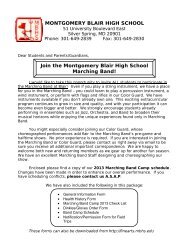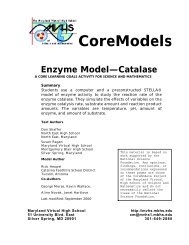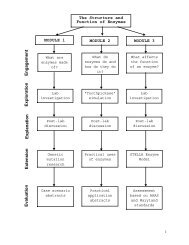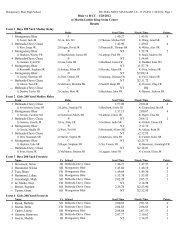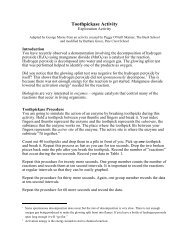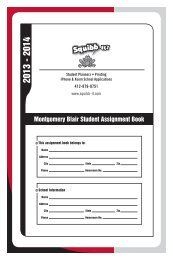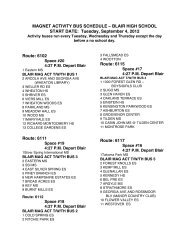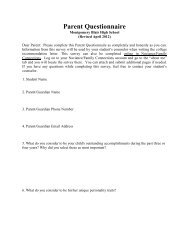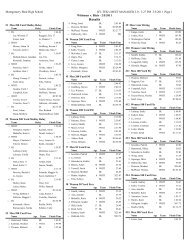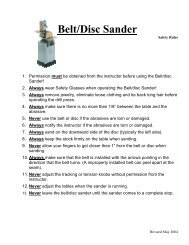Preparing for the test as part of the - Montgomery Blair High School
Preparing for the test as part of the - Montgomery Blair High School
Preparing for the test as part of the - Montgomery Blair High School
Create successful ePaper yourself
Turn your PDF publications into a flip-book with our unique Google optimized e-Paper software.
PREPARING FOR THE<br />
TEST AS PART OF<br />
THE APPLICATION PROCESS<br />
Richard <strong>Montgomery</strong> <strong>High</strong> <strong>School</strong><br />
International Baccalaureate Diploma Program<br />
<strong>Montgomery</strong> <strong>Blair</strong> <strong>High</strong> <strong>School</strong><br />
Science, Ma<strong>the</strong>matics, Computer Science<br />
Magnet Program<br />
Poolesville <strong>High</strong> <strong>School</strong><br />
A Whole <strong>School</strong> Magnet<br />
• Global Ecology • Humanities<br />
• Science, Ma<strong>the</strong>matics,<br />
Computer Science
Inside this packet you will find in<strong>for</strong>mation to<br />
help you answer <strong>the</strong> following questions<br />
about <strong>the</strong> magnet <strong>test</strong>:<br />
Why should I take <strong>the</strong> <strong>test</strong>?<br />
What’s on <strong>the</strong> <strong>test</strong>?<br />
How can I best prepare <strong>for</strong> <strong>the</strong> <strong>test</strong>?<br />
What do <strong>the</strong> <strong>test</strong> questions look like?<br />
How can I practice?<br />
1
Why should I take <strong>the</strong> <strong>test</strong>?<br />
Taking <strong>the</strong> <strong>test</strong> is <strong>part</strong> <strong>of</strong> <strong>the</strong> application process <strong>for</strong> entry into<br />
three <strong>Montgomery</strong> County Public <strong>School</strong>s countywide high school<br />
special programs that are among <strong>the</strong> best in <strong>the</strong> world. At <strong>Montgomery</strong><br />
<strong>Blair</strong> <strong>High</strong> <strong>School</strong> <strong>the</strong> Science, Ma<strong>the</strong>matics, Computer<br />
Science Magnet Program <strong>of</strong>fers accelerated, interdisciplinary<br />
courses in science, ma<strong>the</strong>matics, and computer science. At Richard<br />
<strong>Montgomery</strong> <strong>High</strong> <strong>School</strong> <strong>the</strong> International Baccalaureate Diploma<br />
Program is an international program that includes honors<br />
and college-level work in English, science, math, <strong>for</strong>eign language,<br />
social studies, and a sixth subject <strong>of</strong> your choice. And<br />
Poolesville <strong>High</strong> <strong>School</strong>, A Whole <strong>School</strong> Magnet, <strong>of</strong>fers students<br />
rigorous programs in three are<strong>as</strong>: global ecology; <strong>the</strong> humanities;<br />
and science, ma<strong>the</strong>matics, and computer science.<br />
The <strong>test</strong> enables <strong>the</strong> selection committee to identify your<br />
strengths <strong>as</strong> a thinker and problem-solver, <strong>as</strong> well <strong>as</strong> <strong>as</strong>sessing<br />
your verbal and ma<strong>the</strong>matical skills. The <strong>test</strong> results are not <strong>the</strong><br />
only in<strong>for</strong>mation considered when <strong>the</strong> programs’ selection committees<br />
meet to select students <strong>for</strong> <strong>the</strong> incoming freshman cl<strong>as</strong>s in<br />
each school. They also look at your middle school grades, your<br />
teachers’ recommendations, your application <strong>for</strong>m, and an essay<br />
written at <strong>the</strong> time <strong>of</strong> <strong>test</strong>ing. They want to understand what special<br />
qualities or strengths <strong>as</strong> a learner have enabled you to succeed<br />
in middle school.<br />
3
What’s on <strong>the</strong> <strong>test</strong>?<br />
On <strong>the</strong> <strong>test</strong>ing date you will take a two-hour <strong>test</strong> designed specifically<br />
<strong>for</strong> <strong>the</strong> <strong>Montgomery</strong> County Public <strong>School</strong>s by a national<br />
<strong>test</strong>ing service. In addition, you will write a one-page essay in response<br />
to a writing prompt that you will receive at <strong>the</strong> <strong>test</strong>ing site.<br />
The essay will help <strong>the</strong> committee get to know you <strong>as</strong> a person<br />
and will enable <strong>the</strong>m to <strong>as</strong>sess your written communication skills.<br />
The <strong>test</strong> contains two sections: a verbal section and a math section.<br />
The verbal section consists <strong>of</strong> vocabulary, logical re<strong>as</strong>oning,<br />
and reading comprehension items. The math section consists <strong>of</strong><br />
ma<strong>the</strong>matical problems and quantitative comparison items. Samples<br />
<strong>of</strong> <strong>the</strong>se types <strong>of</strong> questions appear later in this booklet.<br />
You have <strong>the</strong> choice to start with <strong>the</strong> math or verbal section. If<br />
you finish <strong>the</strong> first section be<strong>for</strong>e one hour elapses, you may continue<br />
to <strong>the</strong> second section. The <strong>test</strong> proctor will tell you when<br />
one hour h<strong>as</strong> p<strong>as</strong>sed and will alert you to begin <strong>the</strong> second section.<br />
If you have time, you WILL be able to return to <strong>the</strong> first section<br />
and review answers or complete unfinished items.<br />
Each item on <strong>the</strong> <strong>test</strong> h<strong>as</strong> only one correct answer. Your score<br />
will be b<strong>as</strong>ed on <strong>the</strong> number <strong>of</strong> correct answers, and points will<br />
not be deducted <strong>for</strong> wrong answers. There<strong>for</strong>e, it is in your<br />
best interest to try to answer every question.<br />
After <strong>the</strong> <strong>test</strong> is finished, you will have a short break be<strong>for</strong>e you<br />
begin <strong>the</strong> essay. Then you will have thirty minutes to write your<br />
essay.<br />
4
How can I best prepare <strong>for</strong> <strong>the</strong> <strong>test</strong>?<br />
You have already done <strong>the</strong> most important preparation by studying<br />
hard at school, reading regularly, and stretching yourself to do<br />
challenging work. The skills in reading, re<strong>as</strong>oning, ma<strong>the</strong>matics,<br />
and writing that you have developed over <strong>the</strong> p<strong>as</strong>t eight years will<br />
help you on <strong>test</strong> day.<br />
Here are some tips to incre<strong>as</strong>e <strong>the</strong> likelihood that you will do your<br />
best on <strong>the</strong> <strong>test</strong>.<br />
1. Review <strong>the</strong> sample items that follow. If <strong>the</strong> samples and <strong>the</strong>ir explanations are not clear,<br />
consult with your math or English teacher <strong>for</strong> <strong>as</strong>sistance. Your teachers may want to<br />
develop similar items to practice with students in your cl<strong>as</strong>s. Cramming or attending <strong>test</strong><br />
preparation courses will do little to significantly improve your scores and will take time<br />
away from <strong>the</strong> important studying you need to do <strong>for</strong> your cl<strong>as</strong>ses.<br />
2. Rest well <strong>the</strong> night be<strong>for</strong>e <strong>the</strong> <strong>test</strong>; eat a good breakf<strong>as</strong>t on <strong>the</strong> <strong>test</strong> day.<br />
3. Plan to arrive be<strong>for</strong>e <strong>the</strong> designated time so that you will be relaxed when you enter <strong>the</strong><br />
<strong>test</strong> room. Some nervousness is normal, but do not put so much emph<strong>as</strong>is on <strong>the</strong> <strong>test</strong><br />
that you freeze.<br />
4. Bring several sharpened #2 pencils and your student ID number if you are a <strong>Montgomery</strong><br />
County Public <strong>School</strong> student.<br />
5. Do not bring a calculator or a calculator watch. They may not be used during <strong>the</strong> <strong>test</strong>.<br />
Don’t bring food, beverages, alarm watches, books, or paper.<br />
6. Plan your time. Decide ahead if you will begin with <strong>the</strong> math or verbal section. Keep in<br />
mind how much time you have to work on a section and <strong>the</strong> number <strong>of</strong> items on that section.<br />
Look up periodically to see how much time remains. These strategies will help you<br />
maintain a re<strong>as</strong>onable <strong>test</strong>ing pace.<br />
7. Read <strong>the</strong> instructions carefully. You may underline key words on <strong>the</strong> <strong>test</strong> booklet.<br />
8. Keep your eyes on your own paper so that proctors will not mistake wandering eyes <strong>for</strong><br />
attempts at cheating.<br />
9. If you finish early, go back and review your answers. Check that you have carefully filled<br />
in <strong>the</strong> correct answer on <strong>the</strong> answer sheet. Look closely <strong>for</strong> o<strong>the</strong>r careless mistakes,<br />
such <strong>as</strong> marking an answer next to <strong>the</strong> incorrect question number. Be sure that you<br />
5
have attempted to answer every question because <strong>the</strong>re is no additional penalty <strong>for</strong> incorrect<br />
answers. Your score is b<strong>as</strong>ed on <strong>the</strong> total number <strong>of</strong> correct answers.<br />
10. Do not become upset or distracted by difficult questions. No one is expected to get all<br />
<strong>the</strong> answers correct. After a re<strong>as</strong>onable attempt at <strong>the</strong> questions, go on to o<strong>the</strong>r <strong>test</strong><br />
items and <strong>the</strong>n return to work on <strong>the</strong> difficult questions at <strong>the</strong> end <strong>of</strong> <strong>the</strong> <strong>test</strong>. Make sure<br />
that you indicate items you have skipped on your <strong>test</strong> booklet. Also, when you skip an<br />
item, check that you have placed your next answer beside <strong>the</strong> correct item number.<br />
Here are some tips <strong>for</strong> <strong>the</strong> essay portion <strong>of</strong> <strong>the</strong> <strong>test</strong>ing.<br />
1. When you begin <strong>the</strong> essay section <strong>of</strong> <strong>the</strong> magnet <strong>test</strong>, read <strong>the</strong> prompt carefully. It will<br />
resemble <strong>the</strong> following prompt, which w<strong>as</strong> used on <strong>the</strong> 2003 <strong>test</strong>:<br />
Mark Twain, American author and humorist, once wrote, “Work and play<br />
are words used to describe <strong>the</strong> same thing under differing circumstances.”<br />
Is school work or play <strong>for</strong> you? Why? Use examples from your academic<br />
life to support your position in a coherent, meaningful, brief essay.<br />
2. Be<strong>for</strong>e writing your essay response, think and plan <strong>for</strong> about five minutes. You will have<br />
thirty minutes <strong>for</strong> this section <strong>of</strong> <strong>the</strong> <strong>test</strong>.<br />
3. Develop your ide<strong>as</strong> fully with interesting details. A one-paragraph response with generalizations<br />
is not a fully developed, interesting response. A good response to <strong>the</strong> prompt<br />
in #1 might include vivid details about school that support your opinion <strong>of</strong> school <strong>as</strong><br />
work, <strong>as</strong> play, or <strong>as</strong> both. An especially good response might help us understand what<br />
you are thinking <strong>as</strong> you sit in <strong>the</strong> cl<strong>as</strong>sroom or work at home in <strong>the</strong> evening. Review <strong>the</strong><br />
rubric on <strong>the</strong> next page to see specifically how you will be scored.<br />
4. Make sure that <strong>the</strong> essay reflects who you are <strong>as</strong> a student and <strong>as</strong> a human being. Remember<br />
that <strong>the</strong> selection committee will use this essay to <strong>for</strong>m a fuller picture <strong>of</strong> you.<br />
5. Use language that is lively and expressive. The members <strong>of</strong> <strong>the</strong> committee want to see<br />
<strong>the</strong> skill with which you write.<br />
6. Reread your essay to check <strong>for</strong> errors in expression or rambling organization.<br />
6
Magnet Test Essay Scoring Rubric<br />
Level 6<br />
The response is a thoroughly developed essay which fulfills <strong>the</strong> writing purpose.<br />
• H<strong>as</strong> relevant and complete support and elaboration which enhance<br />
ide<strong>as</strong><br />
• Uses a precise organizational strategy which enhances <strong>the</strong> purpose<br />
• Maintains a distinctive voice and deliberate tone<br />
• Uses precise word choice and evocative language<br />
• Demonstrates careful attention to audience’s understanding and interest<br />
• H<strong>as</strong> no errors in usage or conventions that interfere with meaning<br />
Level 5<br />
The response is a well-developed essay which attempts to fulfill <strong>the</strong> writing<br />
purpose.<br />
• H<strong>as</strong> support and elaboration which enhance ide<strong>as</strong>, although <strong>the</strong>se<br />
may not completely fulfill <strong>the</strong> purpose<br />
• Uses an effective organizational strategy that is consistent with <strong>the</strong><br />
purpose<br />
• Maintains a consistent voice and tone<br />
• Uses clear and consistent word choice<br />
• Demonstrates attention to audience’s understanding and interest<br />
• H<strong>as</strong> no errors in usage or conventions that interfere with meaning<br />
Level 4<br />
The response is an organized essay which addresses <strong>the</strong> writing purpose.<br />
• H<strong>as</strong> support and elaboration which may be uneven or incomplete<br />
• Uses an inconsistent or unevenly applied organizational strategy<br />
• Employs an inconsistent voice or inappropriate tone<br />
• Demonstrates an awareness <strong>of</strong> audience’s understanding and interest<br />
• H<strong>as</strong> few, if any, errors in usage or conventions that interfere with<br />
meaning<br />
7
Level 3<br />
The response is an incomplete or oversimplified essay which attempts to<br />
address <strong>the</strong> writing purpose.<br />
• H<strong>as</strong> incomplete or unclear elaboration and support <strong>for</strong> development<br />
<strong>of</strong> ide<strong>as</strong><br />
• Uses an organizational structure that is inconsistent or unclear<br />
• Employs a flat to inappropriate tone and voice<br />
• Demonstrates little awareness <strong>of</strong> audience’s understanding and interest<br />
• H<strong>as</strong> errors in usage or conventions, some <strong>of</strong> which may interfere with<br />
meaning<br />
Level 2<br />
The response is a poorly written essay which attempts to address <strong>the</strong> writing<br />
purpose.<br />
• H<strong>as</strong> support and elaboration that is inadequate<br />
• Uses an unstructured or confusing organizational strategy<br />
• Employs an unidentifiable tone and voice<br />
• Demonstrates no attention to audience’s understanding and interest<br />
• H<strong>as</strong> errors in usage and conventions, some <strong>of</strong> which interfere with<br />
meaning<br />
Level 1<br />
The response provides evidence <strong>the</strong> writer h<strong>as</strong> seen <strong>the</strong> <strong>as</strong>signment and is<br />
attempting to respond to it.<br />
• H<strong>as</strong> no elaboration or support, or <strong>the</strong> development does not support<br />
<strong>the</strong> writing purpose<br />
• Uses little or no organizational structure<br />
• Demonstrates no attention to voice<br />
• Demonstrates no awareness <strong>of</strong> audience<br />
• H<strong>as</strong> errors in usage and conventions which interfere with meaning<br />
Level 0<br />
The response is completely incorrect or irrelevant, or <strong>the</strong>re is no response.<br />
8
What do <strong>the</strong> <strong>test</strong> questions look like?<br />
The following are descriptions <strong>of</strong> <strong>the</strong> different sub<strong>test</strong>s. Actual<br />
sample items and explanations follow.<br />
A. Vocabulary<br />
The vocabulary section <strong>of</strong> <strong>the</strong> <strong>test</strong> relies on your having a broad range <strong>of</strong> experiences with<br />
words and word study. These experiences come from reading high quality texts that are complex<br />
both in content and structure, and from studying word origins. The sentences you must<br />
complete sometimes lack clear contexts so you must have a large vocabulary on which to draw.<br />
B. Logical Re<strong>as</strong>oning<br />
This section <strong>of</strong> <strong>the</strong> <strong>test</strong> requires you to use skills to organize ide<strong>as</strong> and draw logical conclusions.<br />
In some c<strong>as</strong>es, you must be able to determine <strong>the</strong> difference between in<strong>for</strong>mation that you can<br />
<strong>as</strong>sume is <strong>part</strong> <strong>of</strong> <strong>the</strong> situation versus in<strong>for</strong>mation that, although re<strong>as</strong>onable in a larger sense, is<br />
not implied by <strong>the</strong> situation described in <strong>the</strong> problem. The prompt “b<strong>as</strong>ed on <strong>the</strong> in<strong>for</strong>mation<br />
above” is crucial to solving <strong>the</strong>se problems because you can immediately eliminate responses<br />
that are not b<strong>as</strong>ed on <strong>the</strong> given in<strong>for</strong>mation. In o<strong>the</strong>r c<strong>as</strong>es, you might have to consider unfamiliar<br />
content or terms, or you might need to use alternative strategies such <strong>as</strong> drawing a picture,<br />
working backwards, and making lists.<br />
C. Reading Comprehension<br />
All <strong>of</strong> <strong>the</strong> texts will be expository, meaning you will be reading <strong>for</strong> in<strong>for</strong>mation, ra<strong>the</strong>r than <strong>for</strong><br />
literary experience. Some <strong>of</strong> <strong>the</strong> items can be answered by thinking about <strong>the</strong> text <strong>as</strong> it is written.<br />
However, many <strong>of</strong> <strong>the</strong> questions require you to read between <strong>the</strong> lines and think about <strong>the</strong><br />
in<strong>for</strong>mation in a different way. You have to be careful not to impose you own feelings when<br />
choosing a response. All responses are b<strong>as</strong>ed on <strong>the</strong> text, but sometimes <strong>the</strong> answers have<br />
<strong>the</strong> in<strong>for</strong>mation worded slightly differently than what is in <strong>the</strong> actual text.<br />
D. Ma<strong>the</strong>matical Problems<br />
In some c<strong>as</strong>es, you can ei<strong>the</strong>r solve <strong>the</strong> problem using simply computation, or you can use logical<br />
re<strong>as</strong>oning to determine which answer makes sense. Many <strong>of</strong> <strong>the</strong> items require you to be<br />
able to re<strong>as</strong>on through a problem and use a multi-step process to determine <strong>the</strong> solution.<br />
E. Quantitative Comparison<br />
In this section <strong>of</strong> <strong>the</strong> <strong>test</strong>, you compare two quantities and must determine if one is larger than<br />
<strong>the</strong> o<strong>the</strong>r, if <strong>the</strong>y are equal, or if an answer cannot be determined. In some c<strong>as</strong>es, you can just<br />
use computation to select <strong>the</strong> correct response. In o<strong>the</strong>r c<strong>as</strong>es, you need to apply your knowledge<br />
<strong>of</strong> numbers to abstract situations involving unknowns and variables.<br />
9
How can I practice?<br />
Ple<strong>as</strong>e review <strong>the</strong> following sample items carefully. The samples<br />
are presented to you so that you can understand <strong>the</strong> <strong>for</strong>mat <strong>of</strong> <strong>the</strong><br />
<strong>test</strong>. The questions do not reflect <strong>the</strong> exact content <strong>of</strong> <strong>the</strong> <strong>test</strong>.<br />
The preparation you receive by completing <strong>the</strong> practice items and<br />
reviewing <strong>the</strong> explanations <strong>of</strong> <strong>the</strong> answers ensures that, on <strong>the</strong><br />
day <strong>of</strong> <strong>the</strong> <strong>test</strong>, <strong>the</strong> committee is getting an accurate picture <strong>of</strong> <strong>the</strong><br />
concepts you understand and <strong>the</strong> skills you have, instead <strong>of</strong> simply<br />
seeing how well you understand directions. At <strong>the</strong> top <strong>of</strong> each<br />
page <strong>of</strong> questions, you will find a table <strong>of</strong> helpful hints. Use <strong>the</strong>se<br />
ide<strong>as</strong> to understand better how to answer those specific types <strong>of</strong><br />
questions.<br />
11
Read <strong>the</strong> entire<br />
sentence.<br />
Sample Vocabulary Questions<br />
Know your<br />
vocabulary.<br />
Small words<br />
make a big<br />
difference.<br />
Watch out <strong>for</strong><br />
negatives.<br />
Try answering<br />
<strong>the</strong> question<br />
without looking<br />
at <strong>the</strong><br />
choices.<br />
• A judgment made be<strong>for</strong>e all <strong>the</strong> facts are known must be called ____________.<br />
a) Harsh<br />
b) Deliberate<br />
c) Sensible<br />
d) Premature<br />
e) Fair<br />
• The research is so _____________ that it leaves no <strong>part</strong> <strong>of</strong> <strong>the</strong> issue unexamined.<br />
a) Comprehensive<br />
b) Rewarding<br />
c) Sporadic<br />
d) Economical<br />
e) Problematical<br />
• Because her explanation w<strong>as</strong> so clear and well understood by everyone, I told her<br />
that any more details would be _______________.<br />
a) Subjective<br />
b) Eloquent<br />
c) Superfluous<br />
d) Incontrovertible<br />
e) Impervious<br />
13
Sample Vocabulary Questions: Understanding <strong>the</strong> Answers<br />
• A judgment made be<strong>for</strong>e all <strong>the</strong> facts are known must be called premature.<br />
Response D is <strong>the</strong> correct answer <strong>for</strong> this item. Think about what you know about <strong>the</strong> word<br />
“judgment.” Think to yourself: “I know I need all <strong>of</strong> <strong>the</strong> facts be<strong>for</strong>e I can make a good judgment<br />
about something, so <strong>the</strong> word I’m looking <strong>for</strong> must mean something about making an<br />
unin<strong>for</strong>med judgment.” Premature is a better response than harsh because harsh implies<br />
something bad or wrong while premature implies something w<strong>as</strong> done too early. Reading <strong>the</strong><br />
entire sentence is also important because <strong>the</strong> phr<strong>as</strong>e “be<strong>for</strong>e all <strong>the</strong> facts are known” is a big<br />
clue. The word premature h<strong>as</strong> <strong>the</strong> prefix “pre” meaning “be<strong>for</strong>e.”<br />
• The research is so comprehensive that it leaves no <strong>part</strong> <strong>of</strong> <strong>the</strong> issue unexamined.<br />
Response A is <strong>the</strong> correct answer <strong>for</strong> this item. Think about what <strong>the</strong> sentence states about<br />
<strong>the</strong> research. The phr<strong>as</strong>e “leaves no <strong>part</strong>…unexamined” means that <strong>the</strong> correct response<br />
will say something positive about <strong>the</strong> research. While rewarding and economical might both<br />
imply something positive, comprehensive implies taking everything into account. The word<br />
comprehensive is related to <strong>the</strong> word “comprehend,” meaning “understand.” You can infer<br />
from <strong>the</strong> sentence that <strong>the</strong> research helped people understand all <strong>part</strong>s <strong>of</strong> <strong>the</strong> issue.<br />
• Because her explanation w<strong>as</strong> so clear and well understood by everyone, I told her that<br />
any more details would be superfluous.<br />
Response C is <strong>the</strong> correct answer <strong>for</strong> this item. In this c<strong>as</strong>e, it’s really important to have a big<br />
vocabulary. From <strong>the</strong> sentence, you can infer that <strong>the</strong> correct response will say something<br />
about “additional details” not being needed or taking away from <strong>the</strong> story. The word superfluous<br />
h<strong>as</strong> <strong>the</strong> stem “super” meaning “extra” or “above and beyond.” Knowing <strong>the</strong> origins <strong>of</strong><br />
words will help you make <strong>the</strong> connection between what <strong>the</strong> sentence means and <strong>the</strong> possible<br />
correct responses.<br />
14
Problems like<br />
<strong>the</strong>se focus<br />
on your ability<br />
to think clearly<br />
when you are<br />
given many<br />
pieces <strong>of</strong> in<strong>for</strong>mation.<br />
Sample Logical Re<strong>as</strong>oning Questions<br />
Draw a figure<br />
to represent<br />
items in a line.<br />
Follow <strong>the</strong> directionscarefully.<br />
Rely only on<br />
<strong>the</strong> in<strong>for</strong>mation<br />
provided<br />
in <strong>the</strong> problem.<br />
Do not<br />
use your own<br />
personal experience<br />
to<br />
draw conclusions.<br />
Don’t worry<br />
about <strong>the</strong> subject<br />
<strong>of</strong> <strong>the</strong><br />
problem. Focus<br />
on key<br />
word like “all,”<br />
“some,”<br />
“none,” etc.<br />
Draw pictures,<br />
make lists, or<br />
o<strong>the</strong>rwise try<br />
to organize<br />
<strong>the</strong> in<strong>for</strong>mation<br />
in <strong>the</strong><br />
problem.<br />
• Several people are standing in a straight line. Starting at one end <strong>of</strong> <strong>the</strong> line Latoya<br />
is counted <strong>as</strong> <strong>the</strong> 5 th person, and starting at <strong>the</strong> o<strong>the</strong>r end she is counted <strong>as</strong> <strong>the</strong> 12 th<br />
person. How many people are in <strong>the</strong> line?<br />
a) 15<br />
b) 16<br />
c) 17<br />
d) 18<br />
e) 19<br />
• Juan is younger than Tammy, and he is older and shorter than Lee. Tammy is taller<br />
and younger than Carmen, yet Carmen is taller than Lee. Which answer represents<br />
<strong>the</strong>se people in order from youngest to oldest?<br />
a) Juan, Carmen, Lee, Tammy<br />
b) Lee, Juan, Tammy, Carmen<br />
c) Lee, Tammy, Juan, Carmen<br />
d) Tammy, Lee, Carmen, Juan<br />
e) Carmen, Tammy, Juan, Lee<br />
• The members <strong>of</strong> <strong>the</strong> Liars Club never tell <strong>the</strong> truth. After <strong>the</strong> school’s spelling bee,<br />
in which <strong>the</strong>re were no ties, one <strong>of</strong> <strong>the</strong>m said, “Katie finished first. Alex beat Katie.<br />
Maria beat Jaron, and Alex came in l<strong>as</strong>t.” Which one <strong>of</strong> <strong>the</strong> following statements is<br />
a valid conclusion b<strong>as</strong>ed on <strong>the</strong> in<strong>for</strong>mation in this problem?<br />
a) The Liars Club cheated on <strong>the</strong> spelling bee.<br />
b) Katie won <strong>the</strong> spelling bee.<br />
c) Members <strong>of</strong> The Liars Club should not be allowed to compete in <strong>the</strong> spelling bee.<br />
d) Jaron beat Maria.<br />
e) Alex won <strong>the</strong> spelling bee.<br />
15
Sample Logical Re<strong>as</strong>oning Questions:<br />
Understanding <strong>the</strong> Answers<br />
• Several people are standing in a straight line. Starting at one end <strong>of</strong> <strong>the</strong> line Latoya is<br />
counted <strong>as</strong> <strong>the</strong> 5 th person, and starting at <strong>the</strong> o<strong>the</strong>r end she is counted <strong>as</strong> <strong>the</strong> 12 th person.<br />
How many people are in <strong>the</strong> line? The correct answer is B, 16.<br />
You can answer this question by careful re<strong>as</strong>oning, or you can draw it out and count. Ei<strong>the</strong>r<br />
way, be careful that you don’t leave Latoya out or count her twice. If Latoya is <strong>the</strong> 5 th person<br />
from one end <strong>of</strong> <strong>the</strong> line, <strong>the</strong>re are 4 people (not counting Latoya) between her and that end<br />
<strong>of</strong> <strong>the</strong> line. If Latoya is <strong>the</strong> 12 th person from <strong>the</strong> o<strong>the</strong>r end <strong>of</strong> <strong>the</strong> line, <strong>the</strong>re are 11 people (not<br />
counting Latoya) between her and that end <strong>of</strong> <strong>the</strong> line. Four people between Latoya and one<br />
end and 11 people between Latoya and <strong>the</strong> o<strong>the</strong>r end add up to 15 people. Add in Latoya<br />
and you have a total <strong>of</strong> 16 people.<br />
• Juan is younger than Tammy, and he is older and shorter than Lee. Tammy is taller and<br />
younger than Carmen, yet Carmen is taller than Lee. Which answer represents <strong>the</strong>se<br />
people in order from youngest to oldest? The correct answer is B, Lee, Juan, Tammy,<br />
Carmen.<br />
This item may seem confusing because it contains extra in<strong>for</strong>mation you don’t need to find<br />
<strong>the</strong> correct answer. You can immediately ignore any in<strong>for</strong>mation about height since <strong>the</strong> question<br />
is about age. The in<strong>for</strong>mation you <strong>the</strong>n get is: Juan is younger than Tammy. Juan is<br />
older than Lee. Tammy is younger than Carmen. Since no one is younger than Lee, he must<br />
be <strong>the</strong> youngest. Since no one is older than Carmen, she must be <strong>the</strong> oldest. That leaves<br />
just 2 answer choices. Since Juan is younger than Tammy, he must be closest to Lee while<br />
Tammy is closest to Carmen.<br />
• The members <strong>of</strong> <strong>the</strong> Liars Club never tell <strong>the</strong> truth. After <strong>the</strong> school’s spelling bee, one <strong>of</strong><br />
<strong>the</strong>m said, “Katie finished first. Alex beat Katie. Maria beat Jaron, and Alex came in l<strong>as</strong>t.”<br />
Which one <strong>of</strong> <strong>the</strong> following statements is a valid conclusion b<strong>as</strong>ed on <strong>the</strong> in<strong>for</strong>mation in<br />
this problem? The correct answer is D, Jaron beat Maria.<br />
For this type <strong>of</strong> item, review all <strong>of</strong> <strong>the</strong> responses first. Answers A and C can be eliminated<br />
immediately because <strong>the</strong>y are not b<strong>as</strong>ed on in<strong>for</strong>mation in <strong>the</strong> problem. Instead, <strong>the</strong>y are<br />
b<strong>as</strong>ed on your own opinion <strong>of</strong> <strong>the</strong> situation. That leaves B, D, and E. Instead <strong>of</strong> trying to put<br />
<strong>the</strong> students in order from first to l<strong>as</strong>t, try evaluating <strong>the</strong> re<strong>as</strong>onableness <strong>of</strong> each answer.<br />
Response B is incorrect because <strong>the</strong> statement in <strong>the</strong> problem is that “Katie finished first.”<br />
Since that is a lie, we know B cannot be correct. Response E is not <strong>the</strong> best choice because<br />
<strong>the</strong> statement in <strong>the</strong> problem is that “Alex came in l<strong>as</strong>t.” While that is a lie, we don’t know if<br />
he came in first, only that he didn’t come in l<strong>as</strong>t; <strong>the</strong>re<strong>for</strong>e, response E is not necessarily correct.<br />
We need to check response D. Response D is <strong>the</strong> best choice because <strong>the</strong> statement<br />
in <strong>the</strong> problem is that “Maria beat Jaron.” Since this is a lie, Maria did not beat Jaron. Because<br />
<strong>the</strong>re were no ties, we can logically conclude <strong>the</strong>n that Jaron did beat Maria, and response<br />
D is <strong>the</strong> best choice.<br />
The students finished <strong>the</strong> spelling bee in this order: 1-Jaron, 2-Katie, 3-Alex, 4-Maria.<br />
16
The answers<br />
come from <strong>the</strong><br />
p<strong>as</strong>sage – not<br />
your own personalexperience.<br />
The p<strong>as</strong>sage<br />
must support<br />
your answer.<br />
Sample Reading Comprehension Questions<br />
Every word<br />
counts.<br />
Try eliminating<br />
choices you<br />
know are false.<br />
Mark <strong>the</strong> p<strong>as</strong>sage<br />
or make<br />
short notes.<br />
Double-check<br />
<strong>the</strong> o<strong>the</strong>r<br />
choices.<br />
Read <strong>the</strong> questions<br />
and answers<br />
carefully.<br />
Pace yourself.<br />
An answer can<br />
be true and still<br />
be <strong>the</strong> wrong<br />
answer <strong>for</strong> that<br />
<strong>part</strong>icular question.<br />
Go back to any<br />
questions you<br />
skipped.<br />
Read <strong>the</strong> p<strong>as</strong>sage entitled “Solar Energy” on <strong>the</strong> back <strong>of</strong> this page. Use <strong>the</strong> in<strong>for</strong>mation to<br />
answer <strong>the</strong> questions below. B<strong>as</strong>e your answers only on what you have read in <strong>the</strong> p<strong>as</strong>sage.<br />
• Which <strong>of</strong> <strong>the</strong> following best tells what this p<strong>as</strong>sage is about?<br />
a) which solar energy design is most economical<br />
b) <strong>the</strong> problems <strong>as</strong>sociated with collecting solar energy<br />
c) why solar energy is <strong>the</strong> best <strong>for</strong>m <strong>of</strong> energy<br />
d) two ways to collect solar energy<br />
e) a history <strong>of</strong> solar energy<br />
• Which <strong>of</strong> <strong>the</strong> following is <strong>the</strong> most likely re<strong>as</strong>on an active design would be chosen<br />
over a p<strong>as</strong>sive design?<br />
a) An active design is less expensive.<br />
b) A structure does not have windows that can face <strong>the</strong> sun.<br />
c) An active design works more efficiently.<br />
d) It is too difficult to install stone and ceramic tiles <strong>for</strong> a p<strong>as</strong>sive design.<br />
e) A p<strong>as</strong>sive design is too unreliable.<br />
• The electric pump and hose system (lines 26-27) allows<br />
a) liquid to run through <strong>the</strong> building to heat <strong>the</strong> rooms.<br />
b) liquid to cool <strong>the</strong> flat-plate collector.<br />
c) <strong>the</strong> active design to be more efficient.<br />
d) warm air to circulate through <strong>the</strong> building.<br />
e) cool air to circulate through <strong>the</strong> building.<br />
• In what sequence do <strong>the</strong> following events occur to collect solar energy in a p<strong>as</strong>sive<br />
design?<br />
I. Sunlight heats <strong>the</strong> walls and floors.<br />
II. The building is positioned to face <strong>the</strong> sun.<br />
III. Heat is rele<strong>as</strong>ed at night.<br />
a) I, II, III<br />
b) I, III, II<br />
c) III, I, II<br />
d) II, III, I<br />
e) II, I, III<br />
17
5<br />
10<br />
15<br />
20<br />
25<br />
30<br />
Solar Energy<br />
Solar energy is <strong>the</strong> direct use <strong>of</strong> <strong>the</strong> Sun’s energy to heat living<br />
spaces. People have used this type <strong>of</strong> energy <strong>for</strong> thousands <strong>of</strong><br />
years. In <strong>the</strong> l<strong>as</strong>t fifty years scientists have renewed <strong>the</strong>ir investigation<br />
into <strong>the</strong> use <strong>of</strong> solar energy <strong>as</strong> an alternative energy<br />
source. They have developed several designs that are able to<br />
collect <strong>the</strong> sun’s energy and convert it to heat <strong>for</strong> use in homes<br />
and commercial buildings.<br />
A p<strong>as</strong>sive solar energy design uses <strong>the</strong> building’s shape, materials,<br />
and its orientation to <strong>the</strong> sun to collect and store <strong>the</strong> sun’s<br />
energy. The building is positioned with large windows facing <strong>the</strong><br />
sun so that it can receive and store heat from <strong>the</strong> sun during <strong>the</strong><br />
winter. During <strong>the</strong> summer, <strong>the</strong> windows are designed to close<br />
or block <strong>the</strong> sun’s energy. On cool, sunny days, sunlight p<strong>as</strong>ses<br />
through <strong>the</strong> south facing windows and heats <strong>the</strong> wall and floors.<br />
Stone and ceramic tiles are used <strong>as</strong> flooring to absorb and retain<br />
<strong>the</strong> sun’s heat. At night <strong>the</strong> walls and floors slowly rele<strong>as</strong>e <strong>the</strong><br />
heat. Heat may also be stored by placing liquid inside containers<br />
placed in <strong>the</strong> rooms, <strong>the</strong> walls, or <strong>the</strong> floor to absorb <strong>the</strong> sun’s<br />
energy by day and rele<strong>as</strong>e it by night.<br />
An active design is used where windows cannot face <strong>the</strong> sun.<br />
This design uses a flat-plate collector to capture and store <strong>the</strong><br />
sun’s heat. The collector consists <strong>of</strong> an insulated box which is<br />
placed on <strong>the</strong> ro<strong>of</strong> or somewhere else where it can be warmed<br />
by <strong>the</strong> sun’s energy. Inside <strong>the</strong> box is a long, curved tube filled<br />
with liquid. The tube is connected to an electric pump and hose<br />
system that runs into <strong>the</strong> building. As <strong>the</strong> liquid is heated, it is<br />
pumped through <strong>the</strong> system. The liquid gives up its heat <strong>as</strong> it<br />
p<strong>as</strong>ses through <strong>the</strong> cooler rooms, warming <strong>the</strong>m. Then <strong>the</strong><br />
cooled liquid returns to <strong>the</strong> flat-plate collector where it is heated<br />
once again by <strong>the</strong> sun’s energy.<br />
18
Sample Reading Comprehension Questions:<br />
Understanding <strong>the</strong> Answers<br />
• Which <strong>of</strong> <strong>the</strong> following best tells what this p<strong>as</strong>sage is about? The correct response<br />
is D, two ways to collect solar energy.<br />
Start by reviewing each <strong>of</strong> <strong>the</strong> responses. A, B, and C all contain ide<strong>as</strong> not brought up in <strong>the</strong> reading<br />
selection. There is no mention <strong>of</strong> money, problems with <strong>the</strong> designs, or a discussion <strong>of</strong> advantages<br />
and disadvantages. That leaves D and E. It is tempting to choose E because <strong>the</strong> first paragraph<br />
does describe some <strong>of</strong> <strong>the</strong> background to solar energy collection. However, <strong>the</strong> focus <strong>of</strong> <strong>the</strong> reading<br />
is on <strong>the</strong> two different designs. There<strong>for</strong>e, D is <strong>the</strong> best answer. This is one <strong>of</strong> those situations where<br />
you must select <strong>the</strong> best answer, even though more than one answer might seem correct.<br />
• Which <strong>of</strong> <strong>the</strong> following is <strong>the</strong> most likely re<strong>as</strong>on an active design would be chosen<br />
over a p<strong>as</strong>sive design? The correct response is B, a structure does not have windows<br />
that can face <strong>the</strong> sun.<br />
In this c<strong>as</strong>e, you need to be sure to b<strong>as</strong>e your response on <strong>the</strong> in<strong>for</strong>mation in <strong>the</strong> reading. You might<br />
know a lot about solar energy collection and so you might be tempted to choose one <strong>of</strong> <strong>the</strong> o<strong>the</strong>r responses.<br />
However, <strong>the</strong> only response that is b<strong>as</strong>ed on <strong>the</strong> reading is B. Line 21 specifically<br />
states, “An active design is used where windows cannot face <strong>the</strong> sun.”<br />
• The electric pump and hose system (lines 26-27) allows The correct answer is A, liquid<br />
to run through <strong>the</strong> building to heat <strong>the</strong> rooms.<br />
In this c<strong>as</strong>e, you are directed back to specific lines in <strong>the</strong> reading. You should immediately look <strong>for</strong><br />
clues in that area <strong>of</strong> <strong>the</strong> reading. There is no in<strong>for</strong>mation in <strong>the</strong> reading about efficiency or circulating<br />
air, so you can rule out C, D, and E. This type <strong>of</strong> question can also be tricky because <strong>of</strong> <strong>the</strong> technical<br />
language involved, such <strong>as</strong> flat-plate collector. The flat plate collector is mentioned at <strong>the</strong> beginning<br />
and end <strong>of</strong> <strong>the</strong> paragraph, but <strong>the</strong>re is no in<strong>for</strong>mation about using liquid to cool it, only that <strong>the</strong> cooled<br />
liquid gets reheated by <strong>the</strong> flat-plate collector. However, in lines 28-29, it says, “The liquid gives up its<br />
heat <strong>as</strong> it p<strong>as</strong>ses through <strong>the</strong> cooler rooms, warming <strong>the</strong>m.” From this sentence you can infer, or<br />
conclude, that it means something similar to response A.<br />
• In what sequence do <strong>the</strong> following events occur to collect solar energy in a p<strong>as</strong>sive design?<br />
The correct answer is E: II, I, III.<br />
A good way to approach this type <strong>of</strong> problem is NOT to look at <strong>the</strong> responses first. Instead, put <strong>the</strong>m<br />
in <strong>the</strong> order you think is correct. The question directs you back to <strong>the</strong> paragraph about p<strong>as</strong>sive design.<br />
It is <strong>the</strong>re that you can find in<strong>for</strong>mation to help you. You don’t have to rely on your memory!<br />
Just reread <strong>the</strong> text. Once you have decided on an order, look to see if your order is one <strong>of</strong> <strong>the</strong> responses.<br />
If it is, great! If it isn’t, think about which <strong>part</strong> you are sure about. For example, if you were<br />
sure “II” h<strong>as</strong> to be first, use that idea to eliminate responses that don’t have “II” <strong>as</strong> <strong>the</strong> first item. Then<br />
you can check <strong>the</strong> remaining answers against what you read in <strong>the</strong> text.<br />
19
If it seems like a lot <strong>of</strong><br />
calculating to do, look<br />
<strong>for</strong> a shortcut. Use<br />
logical re<strong>as</strong>oning and<br />
number sense instead<br />
<strong>of</strong> relying on calculation.<br />
Label diagrams and<br />
figures with <strong>the</strong> in<strong>for</strong>mation<br />
you have. If no<br />
diagram or figure is<br />
drawn <strong>for</strong> you, draw<br />
your own. It only h<strong>as</strong><br />
to be neat enough <strong>for</strong><br />
you to work with.<br />
Sample Ma<strong>the</strong>matical Multiple-Choice Questions<br />
A quick “make sense”<br />
check be<strong>for</strong>e you start<br />
working on a question<br />
can help you eliminate<br />
some <strong>of</strong> <strong>the</strong> answers<br />
right away.<br />
When checking <strong>the</strong><br />
values <strong>of</strong> expressions,<br />
remember <strong>the</strong> order <strong>of</strong><br />
operations. Also keep<br />
in mind special rules <strong>for</strong><br />
working with positive<br />
and negative numbers.<br />
When <strong>the</strong> math is simple<br />
and you understand<br />
what <strong>the</strong> question is<br />
<strong>as</strong>king, it’s okay to find<br />
<strong>the</strong> answer by checking<br />
each choice and/or<br />
eliminating choices.<br />
If you are presented<br />
with a question that<br />
shows <strong>the</strong> grid lines <strong>of</strong><br />
a graph, you may rely<br />
on <strong>the</strong> accuracy <strong>of</strong><br />
those lines.<br />
Be careful about going<br />
with your “intuition” or<br />
“gut feeling.” Sometimes<br />
<strong>the</strong>re are incorrect<br />
response choices<br />
that look correct at first<br />
glance.<br />
You are not scored on<br />
how you approach <strong>the</strong><br />
problem, only on which<br />
solution you choose.<br />
• Which <strong>of</strong> <strong>the</strong> following integers is a divisor <strong>of</strong> both 36 and 90?<br />
a) 12<br />
b) 10<br />
c) 8<br />
d) 6<br />
e) 4<br />
• If 4 (X-1) – 3X = 12, <strong>the</strong>n X =<br />
a) 4<br />
b) 8<br />
c) 11<br />
d) 13<br />
e) 16<br />
• A car averages 20 miles per gallon in city driving and 30 miles per gallon in highway driving.<br />
At <strong>the</strong>se rates, how many gallons <strong>of</strong> g<strong>as</strong> will <strong>the</strong> car use on a 300-mile trip if 4/5 <strong>of</strong> <strong>the</strong><br />
trip is highway driving and <strong>the</strong> rest is city driving?<br />
a) 5<br />
b) 11<br />
c) 14<br />
d) 20<br />
e) 25<br />
• A b<strong>as</strong>ketball player h<strong>as</strong> a mean <strong>of</strong> 22 points per game <strong>for</strong> 8 games. What is <strong>the</strong> total number<br />
<strong>of</strong> points this player must score in <strong>the</strong> next 2 games in order to have an average <strong>of</strong> 20<br />
points per game <strong>for</strong> 10 games?<br />
a) 18<br />
b) 20<br />
c) 22<br />
d) 24<br />
e) 34<br />
20
Sample Ma<strong>the</strong>matical Multiple-Choice Questions:<br />
Understanding <strong>the</strong> Answers<br />
• Which <strong>of</strong> <strong>the</strong> following integers is a divisor <strong>of</strong> both 36 and 90? The correct answer is D,<br />
6.<br />
A divisor is a number by which ano<strong>the</strong>r number can be divided. If you <strong>for</strong>got what a divisor is,<br />
think about some o<strong>the</strong>r clues in <strong>the</strong> item. The word “divisor” h<strong>as</strong> <strong>the</strong> word “divide” in it, so <strong>the</strong><br />
correct response must link 36, 90, and division. Ano<strong>the</strong>r clue is <strong>the</strong> word “both.” This implies<br />
that <strong>the</strong> correct response tells you something that 36 and 90 have in common. Do some<br />
quick mental math to figure out which number 36 and 90 have in common through division.<br />
• If 4 (X-1) – 3X = 12, <strong>the</strong>n X = The correct answer is E, 16.<br />
To solve <strong>for</strong> X, use <strong>the</strong> distributive property and combine like-terms:<br />
4(X-1) – 3X = 12<br />
4X – 4 – 3X = 12<br />
(4X - 3X) – 4 =12<br />
X – 4 = 12<br />
X = 16<br />
If you were unsure about how to simplify <strong>the</strong> expression 4 (X-1), you could also work backwards<br />
by substituting each response <strong>for</strong> X to which value <strong>of</strong> X worked to make <strong>the</strong> equation<br />
true.<br />
• A car averages 20 miles per gallon in city driving and 30 miles per gallon in highway driving.<br />
At <strong>the</strong>se rates, how many gallons <strong>of</strong> g<strong>as</strong> will <strong>the</strong> car use on a 300-mile trip if 4/5 <strong>of</strong><br />
<strong>the</strong> trip is highway driving and <strong>the</strong> rest is city driving? The correct answer is B, 11.<br />
This is a multi-step problem that requires proportional thinking. First calculate how many <strong>of</strong> <strong>the</strong> 300<br />
miles are highway miles and how many are city miles:<br />
4/5 <strong>of</strong> 300 is 240 highway miles<br />
1/5 <strong>of</strong> 300 is 60 city miles<br />
(If this calculation looks difficult, make it an e<strong>as</strong>ier problem by thinking about <strong>the</strong> relationship between<br />
5 and 30. Since you know 5 x 6 = 30, 5 x 60 = 300.) Then calculate how many gallons <strong>of</strong> g<strong>as</strong> to drive<br />
<strong>the</strong> 60 miles and <strong>the</strong> 240 miles:<br />
60 miles at one gallon <strong>for</strong> every 20 miles is 3 gallons<br />
240 miles at one gallon <strong>for</strong> every 30 miles is 8 gallons<br />
(If this calculation looks difficult, make it an e<strong>as</strong>ier problem by thinking about <strong>the</strong> relationship between<br />
6 and 2 and between 24 and 3.) Then, find <strong>the</strong> total number <strong>of</strong> gallons needed:<br />
3 gallons + 8 gallons = 11 gallons<br />
What if you didn’t even know where to start? You could make some educated guesses by using<br />
some number sense. Suppose <strong>the</strong> whole 300 miles w<strong>as</strong> highway. That would mean you would need<br />
10 gallons <strong>of</strong> g<strong>as</strong> (think about <strong>the</strong> relationship between 30 and 3). On <strong>the</strong> o<strong>the</strong>r hand, suppose <strong>the</strong><br />
whole 300 miles w<strong>as</strong> city. That would mean you would need 15 gallons <strong>of</strong> g<strong>as</strong> (think about <strong>the</strong> relationship<br />
between 30 and 2). So, <strong>the</strong> correct response must be between 10 and 15. That leaves only<br />
2 possible responses: 11 and 14. Since more <strong>of</strong> <strong>the</strong> 300 miles w<strong>as</strong> highway, which gets better g<strong>as</strong><br />
mileage, 11 would be <strong>the</strong> more re<strong>as</strong>onable response.<br />
21
• A b<strong>as</strong>ketball player h<strong>as</strong> a mean <strong>of</strong> 22 points per game <strong>for</strong> 8 games. What is <strong>the</strong> total<br />
number <strong>of</strong> points this player must score in <strong>the</strong> next 2 games in order to have an average<br />
<strong>of</strong> 20 points per game <strong>for</strong> 10 games? The correct answer is D, 24.<br />
This is a multi-step problem in which you really have to understand <strong>the</strong> concept <strong>of</strong> mean.<br />
Start by thinking about how you calculate mean and work backwards. Over 10 games, an<br />
average <strong>of</strong> 20 points per game were scored. This means some number representing <strong>the</strong> sum<br />
<strong>of</strong> all <strong>of</strong> <strong>the</strong> scores w<strong>as</strong> divided among 10 games:<br />
X / 10 = 20<br />
X = 200<br />
You know that over 8 <strong>of</strong> those 10 games, an average <strong>of</strong> 22 points per game were scored.<br />
This mean some number representing <strong>the</strong> sum <strong>of</strong> all <strong>of</strong> <strong>the</strong> scores w<strong>as</strong> divided among 8<br />
games: X / 8 = 22<br />
X = 176<br />
Now you know that over 10 games <strong>the</strong> player scored 200 points and over 8 games <strong>the</strong> player<br />
scored 176 points. This means <strong>the</strong> player must score ano<strong>the</strong>r 24 points over <strong>the</strong> l<strong>as</strong>t 2<br />
games: 176 + X = 200<br />
X = 24<br />
If it seems difficult to try to remember <strong>the</strong> exact steps in this process, try visualizing what is<br />
meant by <strong>the</strong> in<strong>for</strong>mation. You could try drawing a picture:<br />
1 xxxxxxxxxxxxxxxxxxxxxx<br />
2 xxxxxxxxxxxxxxxxxxxxxx<br />
3 xxxxxxxxxxxxxxxxxxxxxx<br />
4 xxxxxxxxxxxxxxxxxxxxxx<br />
5 xxxxxxxxxxxxxxxxxxxxxx<br />
6 xxxxxxxxxxxxxxxxxxxxxx<br />
7 xxxxxxxxxxxxxxxxxxxxxx<br />
8 xxxxxxxxxxxxxxxxxxxxxx<br />
9 not played yet<br />
10 not played yet<br />
Mean score <strong>of</strong> 22 points per game <strong>for</strong> 8 games<br />
1 xxxxxxxxxxxxxxxxxxxx Remove two x’s from each<br />
2 xxxxxxxxxxxxxxxxxxxx <strong>of</strong> <strong>the</strong> first 8 games and.<br />
3 xxxxxxxxxxxxxxxxxxxx add <strong>the</strong>m to game 9. When you<br />
4 xxxxxxxxxxxxxxxxxxxx do this, you make <strong>the</strong> mean score<br />
5 xxxxxxxxxxxxxxxxxxxx <strong>for</strong> each game 20 points.<br />
6 xxxxxxxxxxxxxxxxxxxx<br />
7 xxxxxxxxxxxxxxxxxxxx<br />
8 xxxxxxxxxxxxxxxxxxxx<br />
9 xxxxxxxxxxxxxxxx____<br />
10 ___________________<br />
Mean score <strong>of</strong> 20 points per game <strong>for</strong> 10 games. How many more<br />
points does <strong>the</strong> player need to score to make it 20 points per game?<br />
22
Frequently you don’t have to<br />
finish your calculations to determine<br />
an exact answer.<br />
You just have to know<br />
enough about <strong>the</strong> quantities<br />
to determine which one is<br />
greater.<br />
Think <strong>of</strong> <strong>the</strong> columns <strong>as</strong> a<br />
balanced scale. Try to figure<br />
out which side is heavier –<br />
eliminate any quantities that<br />
are <strong>the</strong> same on both sides <strong>of</strong><br />
<strong>the</strong> scale.<br />
Sample Quantitative Comparison Questions<br />
Memorize <strong>the</strong> four answer<br />
choices <strong>for</strong> <strong>the</strong>se types <strong>of</strong><br />
questions:<br />
A = A is bigger<br />
B = B is bigger<br />
C = A and B are equal<br />
D = not enough in<strong>for</strong>mation<br />
or more than one <strong>of</strong> <strong>the</strong> o<strong>the</strong>r<br />
answer choices is correct<br />
Try evaluating quantities by<br />
substituting values <strong>for</strong> variables.<br />
Remember to check<br />
<strong>the</strong> columns <strong>for</strong> any in<strong>for</strong>mation<br />
about what <strong>the</strong> values<br />
can or cannot be.<br />
If two <strong>of</strong> <strong>the</strong> answers A, B, or<br />
C can be true <strong>for</strong> a <strong>part</strong>icular<br />
question, <strong>the</strong>n <strong>the</strong> answer to<br />
that question is D.<br />
When substituting values, be<br />
sure to check <strong>the</strong> special<br />
c<strong>as</strong>es such <strong>as</strong> 0, 1, at le<strong>as</strong>t<br />
one number between 0 and<br />
1, a number greater or numbers<br />
greater than 1, negative<br />
numbers.<br />
• Mark A if <strong>the</strong> quantity in Column A is greater;<br />
• Mark B if <strong>the</strong> quantity in Column B is greater;<br />
• Mark C if <strong>the</strong> two quantities are equal;<br />
• Mark D if <strong>the</strong> relationship cannot be determined from <strong>the</strong> in<strong>for</strong>mation given.<br />
Column A Column B<br />
1/3 x 4/7 x 8/9 4/7 x 1/3 x 5/9<br />
1/58 – 1/63 1/57 – 1/65<br />
Distance traveled by an airplane Distance traveled by an airplane<br />
going 200 miles per hour. going 190 miles per hour.<br />
35% <strong>of</strong> 50 50% <strong>of</strong> 35<br />
The number <strong>of</strong> cents in 8n dimes if n>0 The number <strong>of</strong> cents in 3n quarters if n>0<br />
23
Sample Quantitative Comparison Questions:<br />
Understanding <strong>the</strong> Answers<br />
1/3 x 4/7 x 8/9 4/7 x 1/3 x 5/9<br />
The correct response is A, <strong>the</strong> amount in Column A is larger.<br />
When comparing <strong>the</strong>se two expressions, you should immediately notice that portions <strong>of</strong> each expression<br />
are <strong>the</strong> same. There<strong>for</strong>e, you only really need to compare <strong>the</strong> portions that are not <strong>the</strong> same, in<br />
this c<strong>as</strong>e 8/9 and 5/9. Using some number sense will save you a great deal <strong>of</strong> time instead <strong>of</strong> completing<br />
calculations.<br />
1/58 – 1/63 1/57 – 1/65<br />
The correct response is B, <strong>the</strong> amount in Column B is larger.<br />
Since finding a common denominator would be too time consuming to do <strong>the</strong> actual calculations, try<br />
using what you know about fractions. For <strong>the</strong> first fraction in each expression, Column B h<strong>as</strong> a larger<br />
amount (1/57 > 1/58). For <strong>the</strong> second fraction in each expression, Column B h<strong>as</strong> a smaller amount<br />
(1/65 < 1/63). There<strong>for</strong>e, it makes sense that <strong>the</strong> amount in Column B is larger since you are subtracting<br />
<strong>the</strong> smallest amount from <strong>the</strong> largest amount.<br />
Distance traveled by an airplane going 200 miles<br />
per hour.<br />
Distance traveled by an airplane going 190 miles<br />
per hour.<br />
The correct response is D, it cannot be determined.<br />
For this item, you might be tempted to select A because <strong>the</strong> plane is flying f<strong>as</strong>ter. However, you have<br />
not been given <strong>the</strong> amount <strong>of</strong> time each plane w<strong>as</strong> traveling. Suppose <strong>the</strong> first plane only flew <strong>for</strong> one<br />
hour and <strong>the</strong> second plane flew <strong>for</strong> two hours. Since you cannot <strong>as</strong>sume that each plane traveled <strong>the</strong><br />
same amount <strong>of</strong> time, <strong>the</strong> answer cannot be determined.<br />
35% <strong>of</strong> 50 50% <strong>of</strong> 35<br />
The correct response is C, <strong>the</strong> amounts are equal.<br />
Be<strong>for</strong>e doing any computation, think about what you know from <strong>the</strong> problem. In ei<strong>the</strong>r column you<br />
have 35 x 50 involving 2 decimal points (<strong>for</strong> <strong>the</strong> %). There<strong>for</strong>e, <strong>the</strong> expressions must be equal.<br />
The number <strong>of</strong> cents in 8n dimes The number <strong>of</strong> cents in 3n quarters<br />
The correct response is A, <strong>the</strong> amount in Column A is larger.<br />
To do <strong>the</strong> calculations, consider <strong>the</strong> number <strong>of</strong> cents in each coin: 10(8n) = 80n vs. 25(3n) = 75n<br />
Since n is common in both expressions, you can simply compare 80 and 75.<br />
24
Prepared by<br />
The Division <strong>of</strong> Consortia Choice and Application<br />
Program Services<br />
<strong>Montgomery</strong> County Public <strong>School</strong>s<br />
850 Hunger<strong>for</strong>d Drive<br />
Rockville, MD 20850



